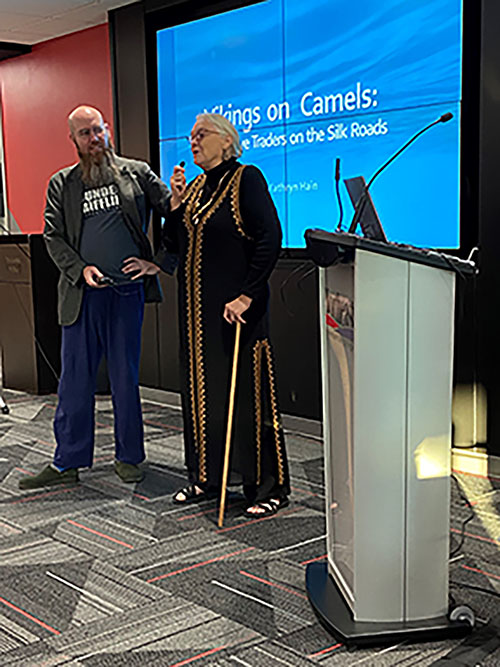NORFOLK, Neb. -- History contains some widely held beliefs. Not all of them are true.
There is a misconception that slaves were Black Africans, usually male, who were brought to the New World.
A recent evening with Kathryn Hain, who presented the first Hawk Talks series of the fall semester, included evidence that belief is a myth. Hain presented, “Vikings on Camels – Norse Slave Trade on the Silk Road.”
“Old World Slavery was usually women and color blind,” Hain told a medium-sized gathering in the lower level of Union 73.
Another myth is that the Vikings were primarily the bane of the Northern Seas and the first settlers of the Americas. In reality, they went much farther south than Europe, selling women as slaves as they traveled, crossing Russia and other areas farther south to Baghdad where they traded.
“The Vikings liked to travel with lots of female slaves because it required labor to travel with all those pelts, along with amber and honey,” Hain said. “But they also had females for sex and for cooking.”
Evidence of this can be found in Arabic texts, and those who met the Vikings and described them in detail. Other evidence comes from DNA, including native American DNA found in Iceland showing how Vikings brought women back to Europe.
Technological changes in ship building allowed Vikings to navigate much longer distances and in rivers with a keel depth of only 18 inches.
“Long before IKEA Furniture became famous in Denmark, the Vikings could take apart these boats made with tight fittings,” Hain said.
That is significant because it meant the Vikings could transport their ships across land and get to another sailing area. If these ships had not come apart, there was no way they could have moved them across the mountains and other places they traversed with the number of people they had, Hain said.
Being able to take apart and reassemble ships meant the Vikings could travel farther and faster.
Material from Hain’s presentation came from her book, “Middle Passage to a Harem; The slave trade of Europeans in the Medieval period.”
The English word slave comes from Slav. Both Muslims and Christians poached Slavs for their slave populations. The male slaves were eunuchs.
So, what is the difference between a Viking and a Norseman? Viking means someone who goes on a sea-bearing journey. Norse just means someone from the north. Vikings, Norse and Scandinavian are mostly interchangeable, she said.
Along with Arabic texts that described the Vikings, there is archeological evidence in Scandinavia of their travels. As an example, there are thousands of Islamic coins that are being found to this day in Sweeden, Hain said.
More Islamic coins have been found in Sweden than in Afghanistan, Hain said. Other artifacts, such as jewelry and silver from the Baghdad area, are found in these northern countries, indicating that trade was taking place. There also are large amounts of silver found from Afghanistan.
The Vikings were described as tremendous fighters, some of whom were hired as mercenaries by other countries.
There also are texts from Western Europe, talking about how the Vikings came down, took over cities and stole the women. They enslaved massive numbers of Europeans to then haul across Russia to sell on the Silks Roads. There even are sources from Spain, describing when the Vikings attacked, the costal people living there fled.
The Vikings usually appeared with a minimum of 40 ships, and sometimes up to 100 ships.
“They overcame anyone they came across at sea, brought them (along) and took them captive. They also came into the land and the cities and took them over,” Hain said. “They were quite feared.”
The Vikings even made it to what is now the United States, although there isn’t certainty among all historians. Viking runes have been found in Maine, Minnesota and Oklahoma.
The script found in Oklahoma was taken to Sweeden, where there are more experts on these types of writings. The runes were ahead of modern writing, so spelling was not universal, but was recognized in Scandinavia as something likely written by these early explorers.
And it is possible that they would have got to Oklahoma, traveling up the Mississippi River and then the Arkansas River, Hain said.
The next Hawk Talk will be on Oct. 12. Tom Elliot will present, The Impact of Education on Our Experiences.
Cutline Hawks Talk 1
Paul Muncy, history/geography instructor and the originator of Hawk Talks, introduces Kathryn Hain, an adjunct history instructor, who discussed Vikings during the first Hawk Talks of the school year.

